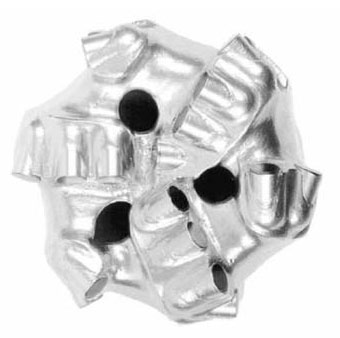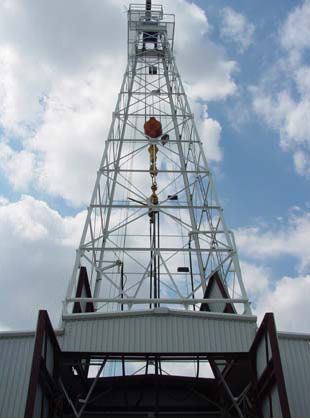Baseline testing of an existing 2 7/8-inch diameter TurboDrill with polycrystalline diamond compact (PDC) and impregnated diamond drill bits was performed successfully at GTI’s Catoosa, OK, field test site. The hydraulic efficiency of the baseline MK2 turbine blades have been increased by 13 percent with the new NASA designed blades. Basic research was performed at NASA Ames Research Center, Mountain View, CA, in evolutionary algorithms, response surface methodology, and geometry modeling and the associated codes were utilized to improve the hydraulic efficiency of the TurboDrill. Flow tests run by Smith Neyrfor indicated that the efficiency of the NASA designed blades may be 80 to 90%, which compares to 55% for the baseline turbine blades previously used in TurboDrills for the past 30 years.
The advanced PDC drill bit employs unique microwave-brazed, thermally stable diamond (TSP) cutters. Use of the cutters allows the bit to be rotated at higher speeds than conventional rotary speeds without the excessive wear that would occur if commercially available PDC cutters were used. Thermal modeling of the TSP cutters revealed an unexpected result: TSP cutters are able to be rotated at speeds of at least 2,000 rpm without excessive wear. Testing at TerraTek in granite and sandstones proved that the cutters can operate at nearly 4000 RPM without excessive wear. Because of their thermal properties, the TSP cutters will operate at a lower temperature when compared with the commercial PDC cutter. Rates of penetration were increased in proportion to the increase in power provided by the NASA designed blades.
The prototype coiled tubing turbine motor and drill bit being developed in this project are designed to:
- Drill a vertical hole to a depth of 5,000 feet.
- Drill laterals to 1,000 feet.
- Demonstrate the economic advantages of the coiled tubing drilling operation when compared with conventional drill pipe-conveyed downhole assemblies.
The performance of the TurboDrill and bit system has lead to an advance in the design of components that ultimately will lead to a higher-power turbine section. Design improvements have been incorporated into a new downhole drilling assembly for a microhole drilling system. Tools will be made available to microhole project partners for independent field applications in re-entry wells and workover operations using commercial coiled tubing rigs.
A thermal model, DragBitTM, has been developed by TII to predict cutter temperatures while drilling hard and abrasive rock at high rpm. Being able to estimate cutter tip temperatures will aid in the development of a more durable drill bit employing high-temperature cutters. DragBitTM is currently being used by drill bit service companies to predice cutter temperatures and wear rates in high rotary speed applications.
A special high-speed laboratory drilling test has been added to the project. Testing has been performed at the Terra Tek Drilling Laboratory in Salt Lake City, UT. The project will provide the TurboDrill and drill bit, and Terra Tek will provide use of the facility and test rocks. . The testing at Terra Tek replaces the field test previously planned. This is because we can accurately measure the improved hydraulic efficiency of the new NASA blades, and the expected drilling rate improvement with rpm’s expected to be about 3000 RPM. Finally, we will rerun the Thermal Model with the actual RPM measured while drilling at TerraTek to estimate long term wear rates of the drill bit cutters.
Optimization and geometry modeling algorithms developed by NASA Ames are used being used to increase the hydraulic efficiency of the existing 2-7/8 inch diameter TurboDrill.
Initial tests of prototype hardware were conducted at drilling research centers to expedite the testing process and to ensure maintenance of carefully controlled operating conditions. Baseline TurboDrill and drill bit testing was completed in March 2005. A turbine blade hydraulic design model was used to redesign the turbine blades, and successful dynamometer testing was completed in June 2005. Further TurboDrill hydraulic modeling was completed.
Finite-element thermal modeling of TSP cutters has been completed, and the results have been incorporated into a new version of an existing drag-bit design code. The new software, called DRAGBIT, is a Windows-based program that calculates cutter forces, cutter temperatures, cutter wear rates, weight-on-bit, drilling torque, and bit imbalance forces for a given bit design, based on downhole operating parameters such as rock type, fluid temperature, fluid cooling rate, rotary speed, and penetration rate. Based on cutter wear rates, the cutter geometries are modified throughout the simulated drilling process to calculate the effects of cutter wear on bit performance. The software allows both TSP and PDC cutters to be specified on the same bit, thereby allowing the user to optimize the placement of TSP cutters in the higher-temperature positions across the bit face. DRAGBIT has been run for a 4-inch diameter fixed-cutter bit design employing both PDC and TSP cutters. Cutter temperatures and wear rates as well as overall bit performance parameters were estimated for rotary speeds up to 2200 RPM in order to simulate drilling with the improved 2-inch diameter TurboDrill. TII has made the DRAGBIT software available to the industry.
Two prototype 2-7/8-inch TurboDrills, both with improved blade designs for increased efficiency, were manufactured by Smith Neyrfor, The first was designed using conventional physical hydraulic models, and the second was designed by NASA AMES using heuristic hydraulic modeling typical of that used to design high performance turbines including the NASA Space Shuttle hydrogen fuel pumps, and military jet engines. Each blade type was incorporated into a 2-7/8-inch TurboDrill and flow tested at the Smith Neyrfor test facility in Houston. The free-wheeling rpm's were well over the 2200 rpm for the baseline TurboDrill blade design. Operating rpm expected to be in the range of 2300 to 3000 rpm, and torques will be measured during testing at the Terre Tek Drilling Simulator in March 2008.
Improvements in the TurboDrill with the NASA blades and the advanced high rotary speed drill bit were incorporated in drilling systems performed at the Terra Tek Drilling Laboratory. Drilling tests in White Sierra Granite and Jackfork Sandstone at RPM’s of 2200 to 4000 RPM indicated higher RPM is proportional to the increased power with the NASA blades. Rates of penetration exceeded 100 feet per hour in White Sierra Granite, well in excess of what had ever been done before at the laboratory.





